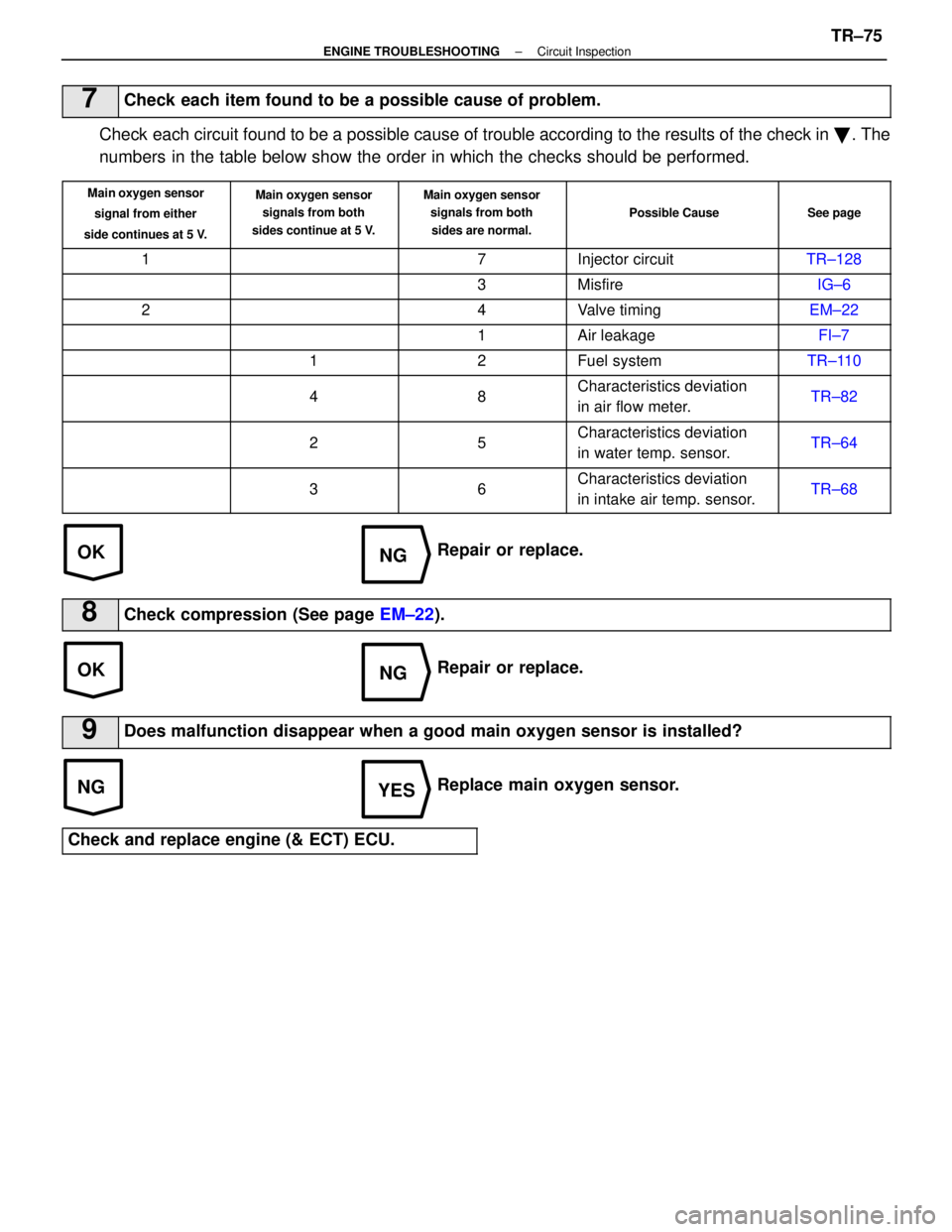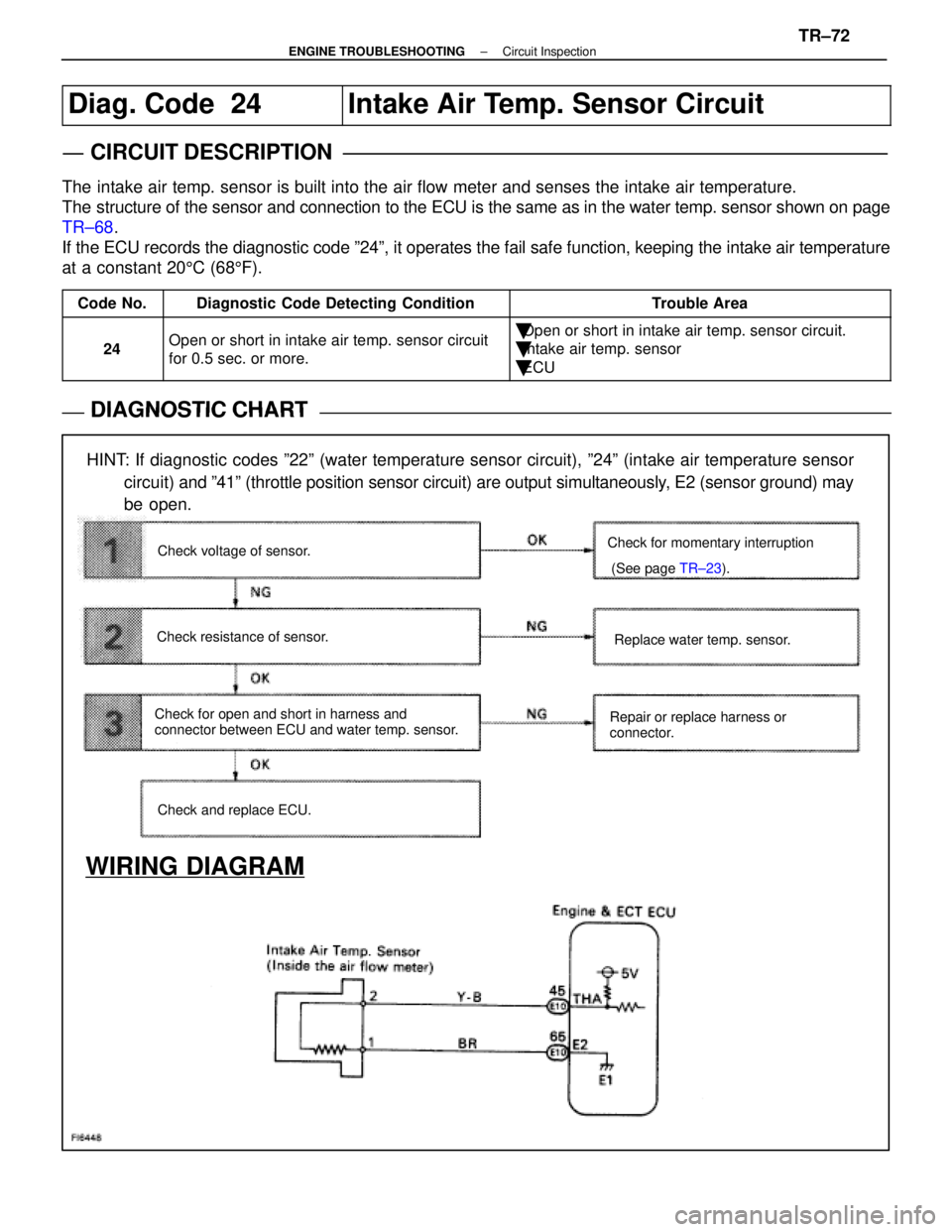Page 3689 of 4087
NG
Type I
NG
Type II
NGOK
INSPECTION PROCEDURE
1Check voltage between terminals VF1, VF2 and E1 of check connector.
C
P
Cau-tion
1. Warm up engine at normal operating temperature
2. Connect terminals TE1 and E1 of check connector.
3. Connect positive prove to terminal VF1, VF2 and
negative prove to terminal E1 of check connector.
1. Warm up the oxygen sensor by running engine at 2,500 rpm for about 2 minutes.
2. Then, maintaining engine at 2,500 rpm, count how many times needle of voltmeter fluctuates between
0 and 5 V.
Go to step �.
2Check voltage between terminals OX1, OX2 and E1 of check connector.
C
OK
Hint
PWarm up engine at normal operating temperature.
Measure voltage between terminals OX1, OX2 and E1
of check connector when engine is suddenly raced to
full throttle.
The voltage should be 0.5 V or higher at least once.
Perform inspection within 1 second.
Go to step �.
±
ENGINE TROUBLESHOOTING Circuit InspectionTR±73
WhereEverybodyKnowsYourName
Page 3690 of 4087

OKNG
OKNG
OKNG
NGYES
3Check for open and short in harness and connector between engine (& ECT) EC\
U and main
oxygen sensor, engine (& ECT) ECU and check connector (See page IN±27).
Repair or replace harness or connector.
4Check each item found to be a possible cause of problem.
Check each circuit found to be a possible cause of trouble according to the r\
esults of the check in ��or
� . The numbers in the table below show the order in which the checks shoul\
d be performed.
Main oxygen sensor
signal from either side
continues at 0 V.Main oxygen sensor
signals from both sides
continue at 0 V.
Possible CauseSee page
1Faulty sensor installation.±
3Injector circuitTR±128
23MisfireIG±6
4Valve timingEM±22
1Air leakageFI±7
2Fuel systemTR±110
6Characteristics deviation
in air flow meter.TR±82
4Characteristics deviation
in water temp. sensor.TR±64
5Characteristics deviation
in intake air temp. sensor.TR±68
Repair or replace.
5Check compression (See page EM±22).
Repair or replace.
6Does malfunction disappear when a good main oxygen sensor is installed?
Replace main oxygen sensor.
Check and replace engine (& ECT) ECU.
TR±74±
ENGINE TROUBLESHOOTING Circuit Inspection
WhereEverybodyKnowsYourName
Page 3691 of 4087

OKNG
OKNG
NGYES
7Check each item found to be a possible cause of problem.
Check each circuit found to be a possible cause of trouble according to the r\
esults of the check in �. The
numbers in the table below show the order in which the checks should be perform\
ed.
Main oxygen sensor
signal from either
side continues at 5 V.Main oxygen sensor signals from both
sides continue at 5 V.Main oxygen sensor signals from both
sides are normal.
Possible CauseSee page
17Injector circuitTR±128
3MisfireIG±6
24Valve timingEM±22
1Air leakageFI±7
12Fuel systemTR±110
48Characteristics deviation
in air flow meter.TR±82
25Characteristics deviation
in water temp. sensor.TR±64
36Characteristics deviation
in intake air temp. sensor.TR±68
Repair or replace.
8Check compression (See page EM±22).
Repair or replace.
9Does malfunction disappear when a good main oxygen sensor is installed?
Replace main oxygen sensor.
Check and replace engine (& ECT) ECU.
±
ENGINE TROUBLESHOOTING Circuit InspectionTR±75
WhereEverybodyKnowsYourName
Page 3692 of 4087

Diag. Code 24Intake Air Temp. Sensor Circuit
CIRCUIT DESCRIPTION
The intake air temp. sensor is built into the air flow meter and senses the\
intake air temperature.
The structure of the sensor and connection to the ECU is the same as in the\
water temp. sensor shown on page
TR±68.
If the ECU records the diagnostic code º24º, it operates the fail \
safe function, keeping the intake air temperature
at a constant 20 5C (68 5F).
Code No.Diagnostic Code Detecting ConditionTrouble Area
24Open or short in intake air temp. sensor circuit
for 0.5 sec. or more.�Open or short in intake air temp. sensor circuit.
�Intake air temp. sensor
�ECU
DIAGNOSTIC CHARTDIAGNOSTIC CHART
HINT: If diagnostic codes º22º (water temperature sensor circuit), º\
24º (intake air temperature sensor
circuit) and º41º (throttle position sensor circuit) are output simultaneousl\
y, E2 (sensor ground) may
be open.
WIRING DIAGRAM
Check and replace ECU. Replace water temp. sensor.
Check for momentary interruption
(See page
TR±23).
Repair or replace harness or
connector.
Check voltage of sensor.
Check resistance of sensor.
Check for open and short in harness and
connector between ECU and water temp. sensor.
±
ENGINE TROUBLESHOOTING Circuit InspectionTR±72
WhereEverybodyKnowsYourName
Page 3693 of 4087
NGOK
OKNG
OKNG
INSPECTION PROCEDURE
1Check voltage between terminals THA and E2 of engine & ECT ECU connector.
C
OK
P(2) Connect the Check Harness A.(See page TR±30)
(2) Turn ignition switch on.
Measure voltage between terminals THA and
E2 and engine & ECT ECU connector.
Check for momentary Intertuption
(See page TR±23).
2Check intake air temp. sensor.
C
OK
PDisconnect the air flow meter connector.
Measure resistance between terminals 1 and 2 of air
flow meter connector.
Resistance is within Acceptable Zone on chart.
Replace intake air temp. sensor (Replace air flow meter).
3
Check for open and short in harness and connector between engine & ECT ECU an\
d intake air
temp. sensor (See page IN±27).
Repair or replace harness or connector.
Check and replace engine & ECT ECU.
TR±73±
ENGINE TROUBLESHOOTING Circuit Inspection
WhereEverybodyKnowsYourName
Page 3694 of 4087

Diag Code
25Air±Fuel Ratio Lean Malfunction
Diag. Code
26Air±Fuel Ratio Rich Malfunction
CIRCUIT DESCRIPTION
Refer to page TR±62 for the circuit description.
Code No.Diagnostic Code Detecting ConditionTrouble Area
(1) Main oxygen sensor voltage is 0.45 V or less (lean)
for 90 sec. under conditions (a) and (b).
(2 trip detection logic)*
(a) Coolant temp.: 60 5C (140 5F) or more.
(b) Engine speed: 1,500 rpm or more.�Open or short in main oxygen sensor circuit
�Main oxygen sensor
�Ignition system
�Water temp. sensor
25 V
26
(2) Main oxygen sensor voltage is alternating above and below 0.45 V at 5 times par
second or more under conditions (a) and (b).
(2 trip detection logic)*
(a) Engine speed: Idling
(b) Coolant temp.: Between 60 5C (140 5F)
and 95 5C (203 5F)
�Open or short in injector circuit.
�Fuel line pressure (injector blockage)
�Air flow meter (air intake)
�Engine ground bolt loose
�Foreign object caught in valve
(3) Difference of air±fuel ratio feedback compensation
value between right and left banks is more than 10
percentage for 30 sec. or more under conditions (a)
and (b).
(2 trip detection logic)*
(a) Engine speed : 2,000 rpm or more.
(b) Coolant temp.: Between 60 5C (140 5F)
and 95 5C (203 5F)
�Fuel line pressure (injector leak, blockage)
�Mechanical system malfunction
(skipping teeth of timing belt)
�Ignition system
*: See page TR±21.
±
ENGINE TROUBLESHOOTING Circuit InspectionTR±74
WhereEverybodyKnowsYourName
Page 3695 of 4087
CIRCUIT DESCRIPTION (Cont'd)
DIAGNOSIS CODE DETECTION DRIVING PATTERN
Purpose of the driving pattern.
(a) To simulate diag. code detecting condition after diag. code is recorded.
(b) To check that the malfunction is corrected when the repair is completed c\
onfirming that diag. code is no longer detected.
Malfunction: Open or Short in Main Oxygen Sensor
�Initiate test mode (See page TR±12).
�Start engine and warm up.
�After engine is warmed up, let it idle for 3 min.
�Perform quick racing to 4,000 rpm three times by accelerator pedal.
�After performing the racing in (4), perform racing at 2,000 rpm for 90\
sec.
HINT: If a malfunction exists, the ºCHECKº engine warning light will light up after 90 sec. from the start of racing.
NOTICE: If the conditions in this test are not strictly followed, detection of t\
he malfunction will not be possible.
TR±75±
ENGINE TROUBLESHOOTING Circuit Inspection
WhereEverybodyKnowsYourName
Page 3697 of 4087
DIAGNOSTIC CHART
DIAGNOSTIC
CHART
WIRING DIAGRAM
Refer to page TR±64 for the WIRING DIAGRAM.
Check and replace ECU. Repair or replace harness or
connector.
Check compression Check and replace ECU.
Does malfunction disappear when a good main
oxygen sensor is installed?
Check compression.
Check each item found to be a possible cause
of problem. Check for open and short in harness and
connector.
Check voltage of terminal OX.
Check voltage of terminal VF.
Replace main oxygen sensor. Repair or replace.
Does malfunction disappear when a good main
oxygen sensor is installed? Check each item found to be a possible cause
of problem. Replace main oxygen sensor.
Repair or replace.
Repair or replace.
Repair or replace.
TR±77±
ENGINE TROUBLESHOOTING Circuit Inspection
WhereEverybodyKnowsYourName